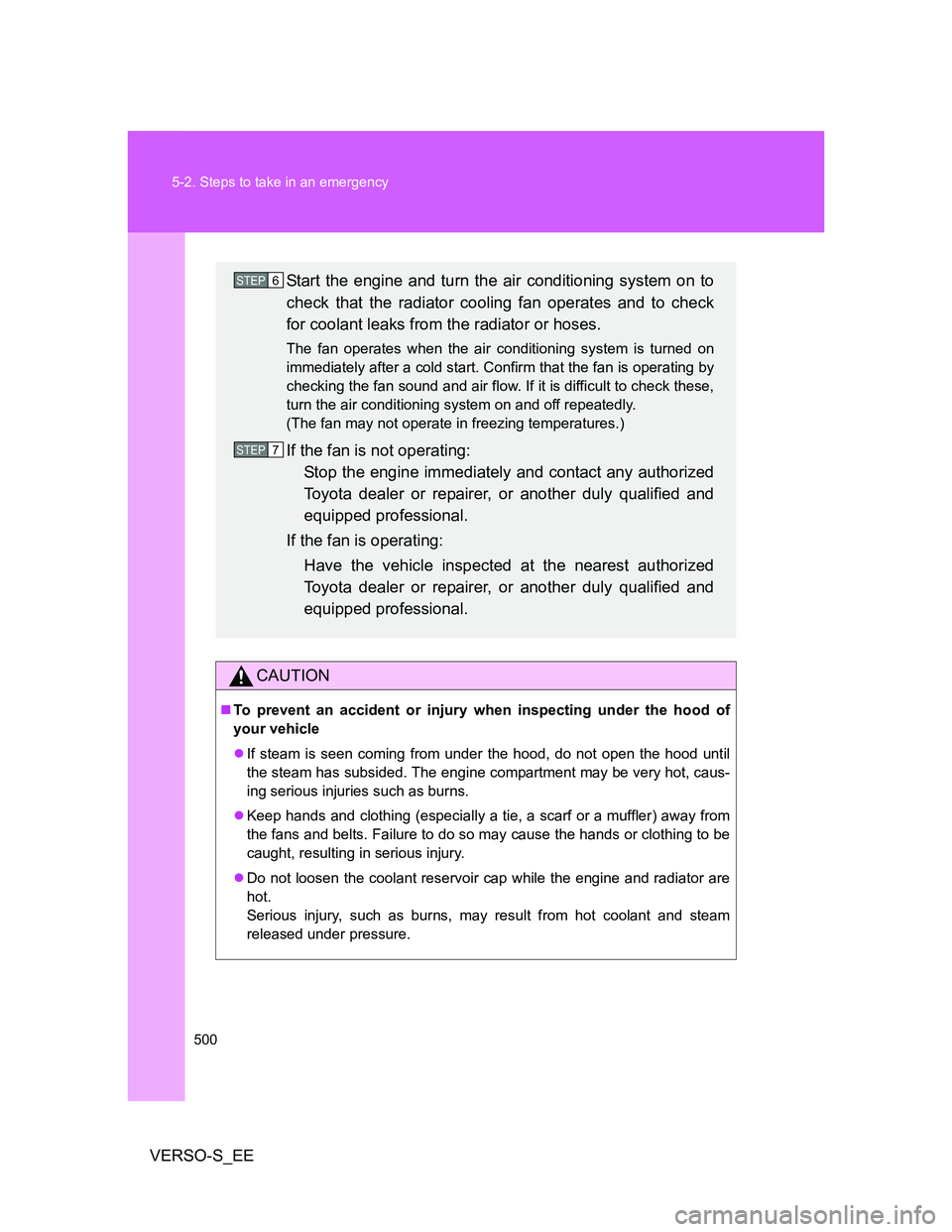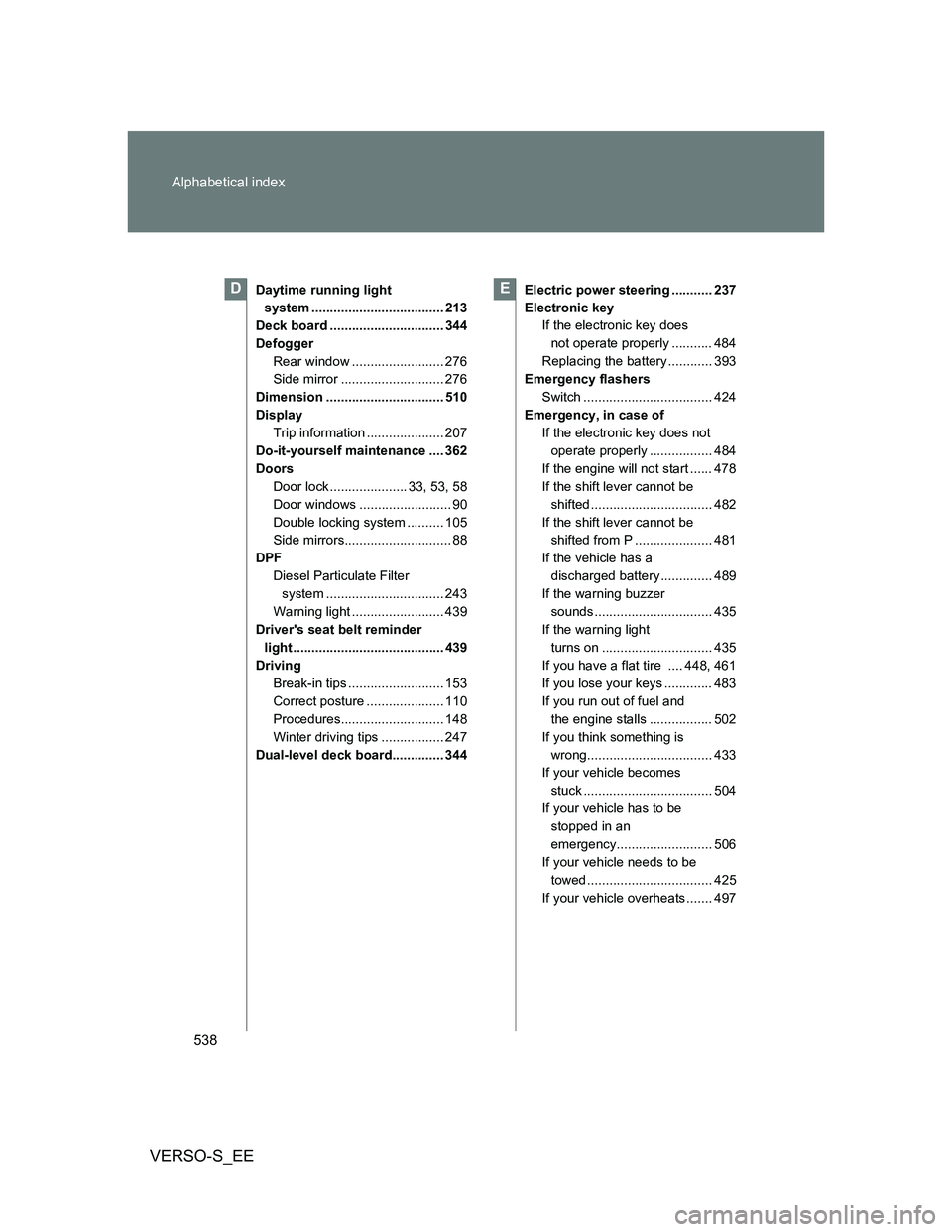Page 492 of 552
492 5-2. Steps to take in an emergency
VERSO-S_EE
Vehicles without a smart entry & start system: Maintain the
engine speed of the second vehicle and turn the engine
switch to the “ON” position, then start the vehicle's engine.
Vehicles with a smart entry & start system: Maintain the
engine speed of the second vehicle and turn the “ENGINE
START STOP” switch to IGNITION ON mode, then start the
vehicle's engine.
Once the vehicle’s engine has started, remove the jumper
cables in the exact reverse order in which they were con-
nected.
Reinstall the cover, and then hook the rubber strip's groove
onto the cover.
Left-hand drive vehicles
Right-hand drive vehiclesSTEP7
STEP8
STEP9
Page 494 of 552

494 5-2. Steps to take in an emergency
VERSO-S_EE
Precautions when the battery is discharged (vehicles with a smart
entry & start system)
In some cases, it may not be possible to unlock the doors using the smart
entry & start system when the battery is discharged. Use the wireless
remote control or the mechanical key to lock or unlock the doors.
The engine may not start on the first attempt after the battery has
recharged but will start normally after the second attempt. This is not a
malfunction.
The “ENGINE START STOP” switch mode is memorized by the vehicle.
When the battery is reconnected, the system will return to the mode it
was in before the battery was discharged. Before disconnecting the bat-
tery, turn the “ENGINE START STOP” switch off.
If you are unsure what mode the “ENGINE START STOP” switch was in
before the battery discharged, be especially careful when reconnecting
the battery.
When the battery is removed or discharged (vehicle with an alarm)
Make sure that the key is not inside the vehicle when recharging or replacing
the battery. The key may be locked in the vehicle if the alarm is activated.
(P. 108)
Page 500 of 552

500 5-2. Steps to take in an emergency
VERSO-S_EE
CAUTION
To prevent an accident or injury when inspecting under the hood of
your vehicle
If steam is seen coming from under the hood, do not open the hood until
the steam has subsided. The engine compartment may be very hot, caus-
ing serious injuries such as burns.
Keep hands and clothing (especially a tie, a scarf or a muffler) away from
the fans and belts. Failure to do so may cause the hands or clothing to be
caught, resulting in serious injury.
Do not loosen the coolant reservoir cap while the engine and radiator are
hot.
Serious injury, such as burns, may result from hot coolant and steam
released under pressure.
Start the engine and turn the air conditioning system on to
check that the radiator cooling fan operates and to check
for coolant leaks from the radiator or hoses.
The fan operates when the air conditioning system is turned on
immediately after a cold start. Confirm that the fan is operating by
checking the fan sound and air flow. If it is difficult to check these,
turn the air conditioning system on and off repeatedly.
(The fan may not operate in freezing temperatures.)
If the fan is not operating:
Stop the engine immediately and contact any authorized
Toyota dealer or repairer, or another duly qualified and
equipped professional.
If the fan is operating:
Have the vehicle inspected at the nearest authorized
Toyota dealer or repairer, or another duly qualified and
equipped professional.
STEP6
STEP7
Page 504 of 552

504
5-2. Steps to take in an emergency
VERSO-S_EE
If the vehicle becomes stuck
Carry out the following procedures if the tires spin or the vehicle
becomes stuck in mud, dirt or snow:
Vehicles with a Multidrive: Stop the engine. Set the parking
brake and shift the shift lever in P.
Except vehicles with a Multidrive: Stop the engine. Set the
parking brake and shift the shift lever in N.
Remove the mud, snow or sand from around the stuck tire.
Place wood, stones or some other material under the tires
to help provide traction.
Restart the engine.
Vehicles with a Multidrive: Shift the shift lever to the D or R
and carefully apply the accelerator to free the vehicle.
Vehicles with a multi-mode manual transmission: Shift the
shift lever to the E, M or R and carefully apply the accelera-
tor to free the vehicle.
Vehicles with a manual transmission: Shift the shift lever to
1 or R and carefully apply the accelerator to free the vehi-
cle.
Turn off TRC and VSC if these functions are hampering your
attempts to free the vehicle. (P. 238)
STEP1
STEP2
STEP3
STEP4
STEP5
Page 506 of 552
506
5-2. Steps to take in an emergency
VERSO-S_EE
If your vehicle has to be stopped in an emergency
Only in an emergency, such as if it becomes impossible to stop the
vehicle in the normal way, stop the vehicle using the following pro-
cedure:
Steadily step on the brake pedal with both feet and firmly
depress it.
Do not pump the brake pedal repeatedly as this will increase the
effort required to slow the vehicle.
Shift the shift lever to N.
If the shift lever is shifted to N
After slowing down, stop the vehicle in a safe place by the
road.
Stop the engine.
If the shift lever cannot be shifted to N
Keep depressing the brake pedal with both feet to reduce
vehicle speed as much as possible.
Vehicles without a smart entry
& start system: Stop the
engine by turning the engine
switch to the “ACC” position.
STEP1
STEP2
STEP3
STEP4
STEP3
STEP4
Page 507 of 552
5
507 5-2. Steps to take in an emergency
When trouble arises
VERSO-S_EE
CAUTION
If the engine has to be turned off while driving
Power assist for the brakes and steering wheel will be lost, making the
brake pedal harder to depress and the steering wheel heavier to turn.
Decelerate as much as possible before turning off the engine.
Vehicles without a smart entry & start system: Never attempt to remove
the key, as doing so will lock the steering wheel.
Vehicles with a smart entry &
start system: To stop the
engine, press and hold the
“ENGINE START STOP”
switch for 3 consecutive sec-
onds or more, or press it
briefly 3 times or more in suc-
cession.
Stop the vehicle in a safe place by the road.
Press and hold for 3 seconds or more,
or press briefly 3 times or more
STEP4
STEP5
Page 511 of 552
511 6-1. Specifications
6
Vehicle specifications
VERSO-S_EE
*1: Unladen vehicles
*2: Vehicles without Stop & Start system
*3: Vehicles with Stop & Start system
*4: Except vehicles with leather wrapped steering wheel
*5: Vehicles with leather wrapped steering wheel
Vehicle identification
Vehicle identification number
The vehicle identification number (VIN) is the legal identifier for
your vehicle. This is the primary identification number for your
Toyota. It is used in registering the ownership of your vehicle.
This number is stamped under
the right-hand front seat.
Maximum permissi-
ble axle capacityFront 900 kg (1985 lb.)
Rear 825 kg (1819 lb.)
Drawbar load 50 kg (110 lb.)
Towing capacity
with
brake800 kg (1764 lb.)
without
brake550 kg (1213 lb.)
Page 538 of 552

538 Alphabetical index
VERSO-S_EE
Daytime running light
system .................................... 213
Deck board ............................... 344
Defogger
Rear window ......................... 276
Side mirror ............................ 276
Dimension ................................ 510
Display
Trip information ..................... 207
Do-it-yourself maintenance .... 362
Doors
Door lock ..................... 33, 53, 58
Door windows ......................... 90
Double locking system .......... 105
Side mirrors............................. 88
DPF
Diesel Particulate Filter
system ................................ 243
Warning light ......................... 439
Driver's seat belt reminder
light ......................................... 439
Driving
Break-in tips .......................... 153
Correct posture ..................... 110
Procedures............................ 148
Winter driving tips ................. 247
Dual-level deck board.............. 344Electric power steering ........... 237
Electronic key
If the electronic key does
not operate properly ........... 484
Replacing the battery ............ 393
Emergency flashers
Switch ................................... 424
Emergency, in case of
If the electronic key does not
operate properly ................. 484
If the engine will not start ...... 478
If the shift lever cannot be
shifted ................................. 482
If the shift lever cannot be
shifted from P ..................... 481
If the vehicle has a
discharged battery .............. 489
If the warning buzzer
sounds ................................ 435
If the warning light
turns on .............................. 435
If you have a flat tire .... 448, 461
If you lose your keys ............. 483
If you run out of fuel and
the engine stalls ................. 502
If you think something is
wrong.................................. 433
If your vehicle becomes
stuck ................................... 504
If your vehicle has to be
stopped in an
emergency.......................... 506
If your vehicle needs to be
towed .................................. 425
If your vehicle overheats ....... 497DE